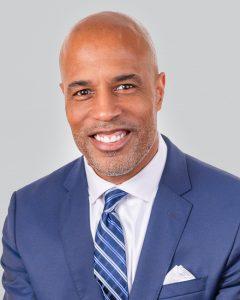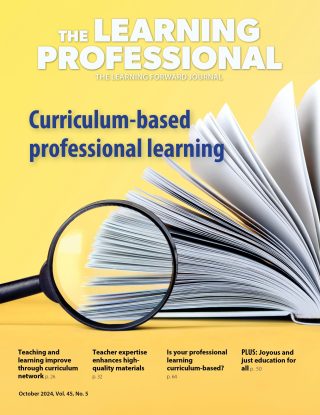FOCUS
Learning Leaders for Learning Schools
Principals who pay attention to their own learning serve as models for others
By Frederick Brown and Kay Psencik
June 2017
Vol. 38 No. 3
Read the remaining content with membership access. Join or log in below to continue.
Sed ut perspiciatis unde omnis iste natus error sit voluptatem accusantium doloremque laudantium, totam rem aperiam, eaque ipsa quae ab illo inventore veritatis et quasi architecto beatae vitae dicta sunt explicabo. Nemo enim ipsam voluptatem quia voluptas sit aspernatur aut odit aut fugit, sed quia consequuntur magni dolores eos qui ratione voluptatem sequi nesciunt. Neque porro quisquam est, qui dolorem ipsum quia dolor sit amet, consectetur, adipisci velit, sed quia non numquam eius modi tempora incidunt ut labore et dolore magnam aliquam quaerat voluptatem.
Frederick Brown (frederick.brown@learningforward.org) is deputy executive director and Kay Psencik (kay.psencik@learningforward.org) is a senior consultant at Learning Forward.
1. Exercise agency and advocacy
One of the most significant aspects of principal professional learning is principals’ advocacy and agency for their own learning. Principal agency is the capacity of school leaders to act purposefully and constructively to direct their professional growth and contribute to the growth of their colleagues.
Rather than responding passively to learning opportunities or not valuing their own professional learning, principals who have agency are aware of the significance of their professional growth and its impact on teacher learning and student success (Calvert, 2016).
Highly effective learning leaders take ownership of their own learning. These learners engage in a cycle of continuous improvement to address issues in their school. They capitalize on others’ expertise and purposefully and intentionally set goals for their own learning.
They establish a community of practice, knowing that the best learning is community learning. They seek out resources essential for them to shift their practices in ways that guide professional learning of everyone in their schools. Instead of waiting for the district or an outside entity to create some type of learning experience, the principal owns her learning gap and takes steps to fill it.
WHAT THIS LOOKS LIKE:
The Twin Tiers Principals Coalition, Corning, New York
Unlike typical professional development, the Twin Tiers Principals Coalition in Corning, New York, provided an extended learning opportunity that emphasized depth of understanding. More than 150 principals from nine districts and Boards of Cooperative Educational Services participating in the coalition engaged in a long-term approach to their own learning.
The coalition, which began in 2003, ran until 2015 in large part because principals valued the learning and advocated for others to join the community. Even as state and local districts experienced many shifts during this time, the fundamental approach and structure of the coalition remained intact. Cohorts of principals learned relevant skills and practices during intensive summer sessions, followed by yearlong support and coaching.
Each cohort also formed communities of practice that met frequently throughout the year — no less than twice monthly. These meetings took place on-site so that principals could walk each other’s campuses and share the school setting. During the school year, a Learning Forward facilitator met with the entire principal cohort for an additional four full days. These extension sessions provided an opportunity for sharing, coaching, extending ideas, problem solving, and overall support. After completing a three-year cycle, principals graduated. Each summer, all cohorts were invited back for a celebration. The coalition of graduates became advocates for their own learning and encouraged their peers to join the learning leaders’ community so all could support each other.
2. Lead professional learning and learning communities
Among the many responsibilities of principals is their role in leading professional learning. The Leadership standard of the Standards for Professional Learning identifies a specific set of behaviors for principals as leaders of learning: “Professional learning that increases educator effectiveness and results for all students requires skillful leaders who develop capacity, advocate, and create systems for professional learning” (Learning Forward, 2011).
So how do principals develop the skills to lead high-achieving learning communities? Principals who are engaged in a community of practice and systematically learn with others know firsthand the significance of systems and structures to foster collective responsibility.
Since they focus on their own learning as a priority, they make time to analyze the needs for the learning communities in their schools and ensure those communities have sufficient time for learning. Though they allow flexibility in the learning agenda for their team, they insist that data conversations determine team and student learning needs.
They ensure teams understand the Standards for Professional Learning, focus on what teams are learning, and provide essential, precise feedback and coaching teams need to get through the hurdles of implementation of new approaches. They foster sharing among teams to encourage them to see that what others are learning can contribute to success around their own goals.
Systems and structures such as setting team goals based on their students’ data, studying, planning lessons together, observing each other teach, and using learning designs that accelerate the learning are all a part of what effective principals design at their schools and what they experience in their own communities of practice.
WHAT THIS LOOKS LIKE:
Galveston ISD, Texas
Four experienced middle school principals in Galveston (Texas) ISD have been working for more than two years to assist their teaching teams in developing units of study aligned across the district. Though they’ve had some success, they didn’t see teachers take much ownership of the work. Everything felt like compliance.
In 2016, the principals formed a community of practice and worked in different ways with the teachers to strengthen the teaching teams’ commitment and consequently produce better results. As they committed to learning more about effective professional learning by becoming a community of practice themselves, they began to see gaps in their work with others.
They designed a new approach for the start of the year: They would focus with the teachers on the “why” behind the work, the value of it to them, and facilitate the teams developing social contracts to clarify their commitments.
Teams analyzed their student performance data to determine their own learning needs. They observed each other, shared teaching strategies, and celebrated progress. With this new approach, they began to see a higher level of engagement with the teams and realized the power of focusing on “why.”
3. Lead curriculum, instruction, and assessment
One of the primary expectations of principals is that they are instructional leaders. We disagree. Principals’ primary role is to be facilitators of learning.
It is not significantly important that principals know calculus — teachers know calculus! But helping teachers of calculus get better at their job requires principals who support and facilitate their learning. Principals need systems and structures to foster the facilitation of teaching teams to design and implement high-yield instruction. Principals need to know how to guide teaching teams to design instruction based on the 21st-century skills essential for all students. Principals need skills to guide teaching teams to develop reliable and valid assessments of and for learning.
While student and staff performance data determine the work of learning communities, principals need to be experts in professional learning and assist learning communities in designing the learning they need to do to get better results for all students.
4. Give precise feedback
Systems thrive on feedback, as we examined in the book Becoming a Learning System (Hirsh, Psencik, & Brown, 2014). It is the clarity about what we and others are observing (self-reflection and observations of others) that gives teams the information they need to make modifications in their approaches.
Feedback, whether developed jointly or given to a team from observational comments, is essential to the community as it continues to learn. As teams use the feedback to reshape their practice and make modifications in their work, they continue the cycle of continuous improvement.
5. Coach effectively
Coaching is another essential strategy for the principal to use both with others and to increase the effectiveness of the principals. Coaches listen effectively (a key skill) and know the right types of questions so teachers and others arrive at their own conclusions, thus deepening their learning.
6. Tap new talent
From a district’s perspective, decisions about who should pursue leadership shouldn’t be left to chance. Districts should take an active role in making sure those emerging leaders who have the knowledge, skills, and dispositions are the ones who get tapped to move into leadership positions.
The principal is uniquely positioned to see those emerging leaders early in their career. Tapping new leadership talent is a core responsibility of learning leaders. This could range from helping identify teacher leaders to encouraging aspiring principals and district leaders to continue on the path to leadership.
References
Calvert, L. (2016). Moving from compliance to agency: What teachers need to make professional learning work. Oxford, OH: Learning Forward & NCTAF.
Hirsh, S., Psencik, K., & Brown, F. (2014). Becoming a learning system. Oxford, OH: Learning Forward.
Learning Forward. (2011). Standards for Professional Learning. Oxford, OH: Author.
Leithwood, K., Louis, K.S., Anderson, S., & Wahlstrom, K. (2004). How leadership influences student learning. Minneapolis, MN: Center for Applied Research and Educational Improvement.
Manna, P. (2015). Developing excellent school principals to advance teaching and learning: Considerations for state policy. New York, NY: The Wallace Foundation.
The Wallace Foundation. (2017). School leadership. Available at www.wallacefoundation.org/knowledge-center/school-leadership/Pages/default.aspx.
Waters, T., Marzano, R.J., & McNulty, B. (2003). Balanced leadership: What 30 years of research tells us about the effect of leadership on student achievement. Denver, CO: McREL.

Frederick Brown is Learning Forward’s president | CEO. Fred is an education visionary who knows firsthand that our nation’s schools need transformational change if we are to meet the challenges of the next decades. Fred advocates that every child deserves to reach their highest potential and every educator must have the opportunity to participate in exemplary, ongoing, professional learning programs to provide students the skills needed to meet their unique needs.
Supporting educators at all levels and improving student achievement are through lines of Fred's career. An elementary school teacher, a middle school assistant principal, and school principal, Fred saw firsthand the impact high-leverage instructional practices and school culture have on school success.
Fred is a frequent speaker on leadership and building high-quality learning in schools. He has co-authored two books that have made significant contributions to the field of education, demonstrating how a comprehensive approach to professional learning can be achieved so that everyone in a system is a learner, and how principals apply a learning lens to their many critical responsibilities to create a productive climate for learning and collaboration. "Becoming a Learning System" and "The Learning Principal -- Becoming a Learning Leader" are time-tested Learning Forward resources for schools and leaders.
Recent Issues
GLOBAL PERSPECTIVES
June 2024
What does professional learning look like around the world? This issue...
WHERE TECHNOLOGY CAN TAKE US
April 2024
Technology is both a topic and a tool for professional learning. This...
EVALUATING PROFESSIONAL LEARNING
February 2024
How do you know your professional learning is working? This issue digs...
TAKING THE NEXT STEP
December 2023
Professional learning can open up new roles and challenges and help...











